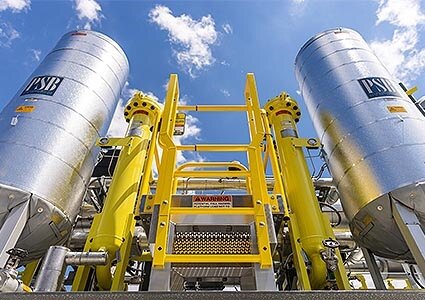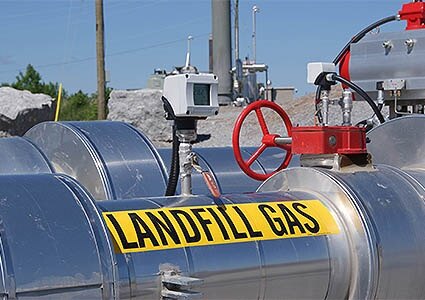Discover how Walker Industries spearheads the transition to landfill gas-powered energy
Headquartered in Niagara Falls, Ontario, Canada, Walker Industries Holdings Ltd (Walker) is a group of companies focused on the efficient construction and operation of energy projects. As such, Walker provides construction materials and services, emulsions, organics recovery, waste services, renewable energy and much more. Offering these high-performance products and services across various sectors, the company has continually developed and diversified into a solutions-based business, supporting and strengthening communities in its operations. Walker tackles challenges with a positive attitude, seeing them as opportunities to meet clients’ evolving needs with an emphasis on environmental concerns. Graham Guest, General Manager of Walker’s Energy and Technical Services division, shares insights into the company’s history.
 “Walker is a sixth-generation family-owned business actively operating within the aggregates, industrial emulsions and environmental services sectors. Established in 1887 with the purchase of a limestone quarry in Niagara Falls, Ontario, the group’s Energy and Technical Services division – amongst many others – still operates from the same location. In 1970, we opened a small industrial landfill, marking our entry into the solid waste management industry. Since then, Walker has opened and operates two additional landfills in Niagara, which are amongst the largest in the Province of Ontario. By 1974, we ventured into the emulsions sector with the purchase of a local asphalt emulsion manufacturer and application contractor that has since morphed into Walker Emulsions. This division serves the building materials sector by supplying board mills, including oriented strand board (OSB), medium density fiber board (MDF), as well as gypsum board plants and fiber-glass insulation manufacturers with high quality waxed-based emulsion from our three facilities in Burlington, ON, Portland, OR and Orangeburg, SC. In 1996, we formed Integrated Municipal Services – now part of Walker Environmental – to address Niagara’s need for a residential leaf and yard waste drop off facility. From then onwards, we have continuously developed and expanded our organics composting and mulch business. As a result of our hard work, Walker currently stands as Canada’s largest organics processor.
“Walker is a sixth-generation family-owned business actively operating within the aggregates, industrial emulsions and environmental services sectors. Established in 1887 with the purchase of a limestone quarry in Niagara Falls, Ontario, the group’s Energy and Technical Services division – amongst many others – still operates from the same location. In 1970, we opened a small industrial landfill, marking our entry into the solid waste management industry. Since then, Walker has opened and operates two additional landfills in Niagara, which are amongst the largest in the Province of Ontario. By 1974, we ventured into the emulsions sector with the purchase of a local asphalt emulsion manufacturer and application contractor that has since morphed into Walker Emulsions. This division serves the building materials sector by supplying board mills, including oriented strand board (OSB), medium density fiber board (MDF), as well as gypsum board plants and fiber-glass insulation manufacturers with high quality waxed-based emulsion from our three facilities in Burlington, ON, Portland, OR and Orangeburg, SC. In 1996, we formed Integrated Municipal Services – now part of Walker Environmental – to address Niagara’s need for a residential leaf and yard waste drop off facility. From then onwards, we have continuously developed and expanded our organics composting and mulch business. As a result of our hard work, Walker currently stands as Canada’s largest organics processor.
Sustainable solutions
“Our renewable energy business began operating around the turn of the millennium with the installation of a landfill gas collection and flaring system at our east landfill in Niagara. Walker hired Comcor Environmental to assist with this first system and then formed a partnership with them that has lasted for more than 20 years. For nearly a decade thereafter, Walker was one of the largest traders of carbon credits in Canada, offsetting the carbon footprint of activities such as air travel through voluntary emissions reduction credits (ERCs) that travelers could purchase from Air Canada. Next, we entered the renewable electricity generation space by developing several landfill-gas-to-electricity facilities across the province. Today, we operate a direct-use project with General Motors, sending landfill gas through a 3.5-kilometer-long bilateral pipeline between our landfill and their engine and transmission facility in St. Catharines, Ontario. Alongside that, we leveraged our experience in the landfill gas-to-energy space by developing our renewable natural gas (RNG) facility, which is set to produce nearly one million gigajoules per year from the gas generated in our landfill. In total, we generate approximately 32 megawatts of power from landfill gas,” Graham adds.
Creating clean energy
Expanding further on the topic, Graham uncovers what led Walker and its partners to develop its own RNG facility. “We have many landfill gas utilization projects on our site, and as more waste is accepted, the volume of landfill gas increases. Walker relentlessly strives to utilize 100 percent of the gas collected at the site to avoid wasteful burning and the unnecessary emissions associated with flaring operations. While we already generate electricity from landfill gas on site, our objective is to make a greater impact in terms of decarbonization. The RNG facility enables us to displace fossil natural gas by utilizing methane captured from our landfill instead, and the methane from landfill gas has a lower carbon intensity. This new facility represents a meaningful step towards reducing the carbon emissions of our society,” he elaborates.
Graham explains the processes and infrastructure in place within the RNG facility at Walker’s site where it generates clean energy for its customers. “Consuming 4000 standard cubic feet per minute, our landfill gas to RNG facility is located at the Walker Environmental landfill in Niagara Falls. Under a 20-year landfill gas supply agreement with the host site, our facility converts raw landfill gas into low-carbon RNG. Leveraging traditional gas separation technologies, including membranes and pressure swing adsorption, the process begins at a centralized landfill gas collection and distribution plant. The gas is then delivered to the RNG facility to the main feed gas blower. Here ensues the first phase of the clean-up process, which consists in removing sulfur from the gas stream by using two vertical static carbon towers to scrub hydrogen sulfide. From there, the gas is chilled to remove moisture, before being pressurized as polymeric membranes separate carbon dioxide from the balance of the gas. Subsequently, nitrogen is eliminated using a pressure swing adsorption system while the gas flows through a series of vessels that are alternately pressurized and rapidly depressurized. The resulting gas, comprising only methane and oxygen, is recompressed and passed through a deoxygenating process. Once oxygen-free, the gas is dried to meet moisture requirements and injected into the local gas distribution network. This network serves customers in North America who are connected to the natural gas distribution grid,” he enlightens.
Paving the way 
Reflecting on the impact of the RNG plant at Walker’s site, Graham shares his thoughts on what other businesses should rethink to tackle the energy transition. “There has been considerable hype surrounding hydrogen in the energy sector, but the reality is that this technology is still years, if not decades, away from impactful widespread deployment. While the industry works towards solving the challenges posed by hydrogen, the RNG market offers valuable insights. It can be used as a roadmap for technology readiness, market development, regulatory framework, and investment tolerance, guiding us through the energy transition and ideally making it easier. In a sense, RNG is helping define the path for future technologies like hydrogen, much like wind and solar energies have done for RNG,” he continues.
Looking to the future, Graham describes what awaits Walker both for the remainder of the year and in the long-term. “For Walker, 2024 focuses on optimizing the new RNG facility as well as recovering resources and creating value-added products from the waste streams in our control. The current RNG plant will produce nearly one million gigajoules per year and our goal is to double that by 2027. Furthermore, we would like to see the continuation of our landfill-gas-to-electricity projects. To that end, Walker is currently working with the regulator to extend its existing Power Purchase Agreements (PPAs) for green energy projects,” he ends.
Within over 130 years in operation, Walker has evolved into a diverse business leading North America’s waste management and renewable energy industries. As the world transitions to renewable resources, Walker is sure to play a key role in the low-carbon future and will undoubtedly realize its targets for RNG production and landfill gas utilization.

